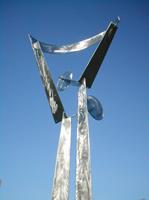
Bryn Mawr College

 |
Center Bryn Mawr College | 
|
February 13, 2003
Katharine Park
(History of Science and Women's Studies, Harvard University)
"Was There a Renaissance Body?"
Part of Katy's work involves dealing with the myth that dissection was a secular practice which arose during the Renaissance, in reaction to medieval religious attitudes. Dissection actually began in medieval Italy around 1170, where it was very much tied to contemporary religious culture. An ancillary question was why contemporary scientists still adher to this myth; their doing so is surely linked to the larger myth that religion and science are generally opposed. Why scientists still insist on THAT myth, which dates from the post-Darwinean moment in which the history of science emerged as a discipline, and is now prevalent in the general historiography of science, was also a question raised but never returned to.
In the histories written by Michel Foucault, especially The Birth of the Clinic (1973), and in the work of those like Barbara Duden who followed him, the vacuum created by the opposition of church and science was filled by accounts of the state and descriptions of an elaborated criminal justice system. In such narratives, the medieval and Renaissance practices of dissecting the body were pathologized, suspicious, the subject of exploitation.
But such clear periodization does not hold in the history of science and medicine; there is too much local variation in culture. Really targeted local histories are needed. Historians and art historians pay too much attention to the history of medicine and science; they think science will tell us the truth about the body, that it "speaks first." But scholars such as Thomas Laqueur, whose Making Sex uses medical texts to explore the meaning of sex difference from the Greeks through Freud, err in ceding authority to science in those earlier periods when it was not culturally hegemonic. Sexual difference was maintained largely in legal and devotional practices, rather than in medical theory (which was written in Latin for a small group of learned men). Biomedical texts should be read as reflections of more broadly held ideas about the body, not as the key, the core of departure, the dominant discourse, but rather only as a small piece of the story.
During the discussion period, it was asked whether the changing practices of dissection were related to changes in art; Katy explained that the artistic nudes did not circulate widely. Was there a rise in the numbers of people disciplining their bodies (in athletics, for instance)? Pummel horse gymnastics, which emphasized the ideal of control, were first practiced during this period; the first how-to books about gymnastics also circulated. There was a marked complexification of court dancing from the 14th through the 16th centuries; in the 17th, it became professionalized. What role did the new epidemic diseases play? Did they give rise to moral and spiritual disciplines? To new hygenic practices? The plague and syphillis "came from somewhere else", from the east, and there was a moralizing discourse associated with attempts to prevent the spread of both.
The resistance to dissection, which was less in Italy than in Northern Europe, was not religious in origin, but came rather out of intense social and cultural feelings about the appropriate treatment of dead bodies, especially those belonging to nearby family members. Why allow a public dissection, for purposes of instruction, of a body that plays a large part in family identity? These questions were more problematic for north Europeans, who made different assumptions about the dead body: death was not thought to be instantaneous, but a gradual loss of sensitivity; they found it hard to think of the recently dead body as really dead. So bodies were shut up in coffins, internments often didn't take place for over a year, and vampire myths flourished.
Dissection grew out of the funerary practice of embalming; 4th c. BCE Alexandrian Egypt was only other culture which practiced both arts. It could be said that medieval Catholicism was organized around dismemberment. There was a cult of municipal saints, whose body parts were thought to be powerful, and so lucrative. The valuation of different kinds of bodies were discussed, from criminals to saints to monarchs, all of whose bodies were handled under a different set of rules. Whose bodies were preserved, and whose dismembered? The body parts of the kings of France, for instance, were buried in various places. The intestines of Louis XIV were displayed to the public (kings had no private lives even when alive; they bathed and used the toilet in public). The bodies of criminals were often dissected, particularly those who were foreign, whose families were not available to claim them. It was useful to find bodies that "belonged to no one"; immigrants and travelers, who died in hospitals because they had no family to care for them, were also available for dissection. What about the commercial aspect, the commodification of bodies? Who was selling them? Did medical students buy miscarried fetuses from midwives, for instance?
Discussion ended with anecdotes about the illegal publication of photographs of Bismarck (who owns a photograph of oneself?) and the German art exhibit of plastinated corpses (in which the fat has been replaced by acrylics) currently on display in London. There was an attempt to revive the theatrical event that was Renaissance dissection, in a public autopsy (which did not take place).
Discussion continued after a public lecture which Katy gave that evening, on "Women's Secrets and the Origins of Human Dissection."
The conversation is invited to continue further on the
On-Line Forum and resume in person next Thursday, February 20, when
Mark Lord will lead us in an enactment of "Tomomi's Dream: Embodying Our Disciplines."
Home
| Calendar | About
| Getting Involved
| Groups | Initiatives | Bryn Mawr Home | Serendip Home
Director: Liz McCormack -
emccorma@brynmawr.edu
| Faculty Steering Committee
| Secretary: Lisa Kolonay
© 1994-
, by Center for Science in Society, Bryn Mawr College and Serendip
Last Modified:
Wednesday, 02-May-2018 11:57:05 CDT